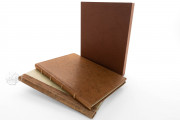Produced in fifteenth-century Nuremberg, Germany, the Codex Schürstab illustrates the effects of the stars on human beings, focusing particularly on the planets that are said to govern certain hours of the day. Their position, orbit, and arrangement in relation to one another as well as to the signs of the Zodiac characterize macroscopic connections that were thought to influence earthly matters.
The codex occupies an important place in ancient German collections as it is a unique and unsurpassed example of this book genre which, by its balanced decoration, conveys the harmony of the medieval view of the world.
A Wealth of Information on the Influence of the Stars
Copied by two scribes, the manuscript starts with genealogical tables regarding the Schürstab dynasty. They are followed by tables indicating the calculation of certain lunar and feast days, completed by a calendar containing the monthly rules. Thereafter follow the constellations in twelve exhaustive, charmingly illustrated chapters.
In the second portion, subjects range from wandering stars and predictions for the New Year to planets which rule the hours as well as descriptions of the upper spheres, and most importantly, a theory of the planets composed of various types of text.
The third part refers to the different temperaments, including a vivid description, which is illustrated by miniatures, of behavior and characteristics associated with the four humors that have been known since Antiquity and were still current in the Middle Ages (choleric, phlegmatic, sanguine or melancholic).
One concluding range of subjects deals in particular with health rules, treating medical aspects such as bloodletting as well as steam baths and cupping, and last but not least air and air pollution.
The work then continues with psychological advice. It concludes with a number of recipes and tables for the calculation of feast days as well as for the determination of the planets governing certain hours.
Fifty-four Astounding Miniatures
The medieval vision of the world was a very closed and harmonic one, a feature which is also indicated in the open-mindedness of its various miniatures. The fifty-four miniatures betray an able artist's hand and are an example of state-of-the-art medieval book illumination.
These true gems of illumination were carried out using the most splendid pigments and shimmering gold leaf. Although relying on traditional motives, the artist used his personal style and variations for the decoration of the book.
The artist combined Gothic realism with ancient German truthfulness, while also referring to the serenity of late medieval bourgeoisie—thus appearing as a sharp and open-minded character with a great delight in observation for the medieval world around him.
We have 1 facsimile edition of the manuscript "Codex Schürstab": Vom Einfluß der Gestirne auf die Gesundheit und den Charakter des Menschen facsimile edition, published by Faksimile Verlag, 1981
Request Info / Price

























